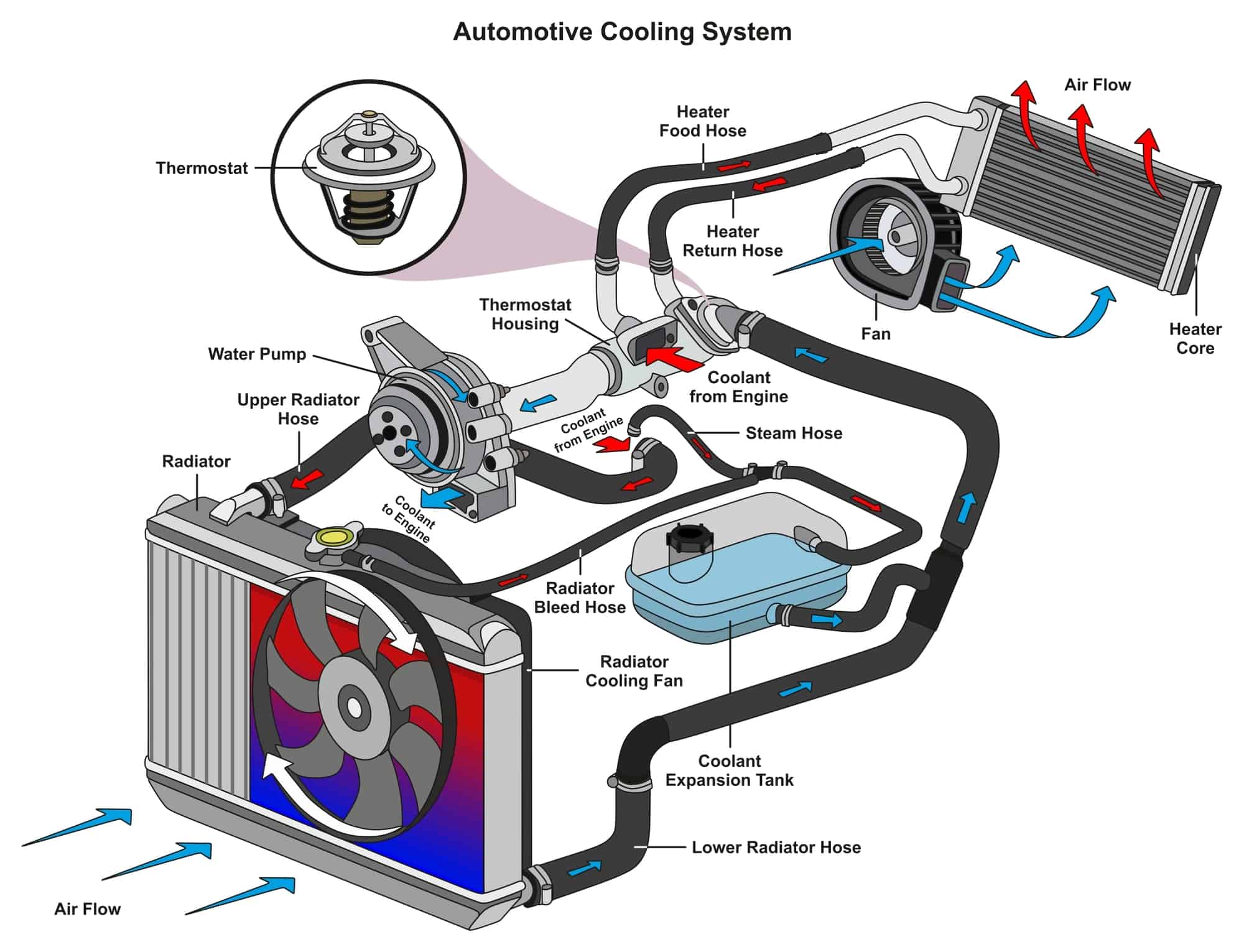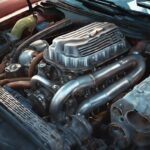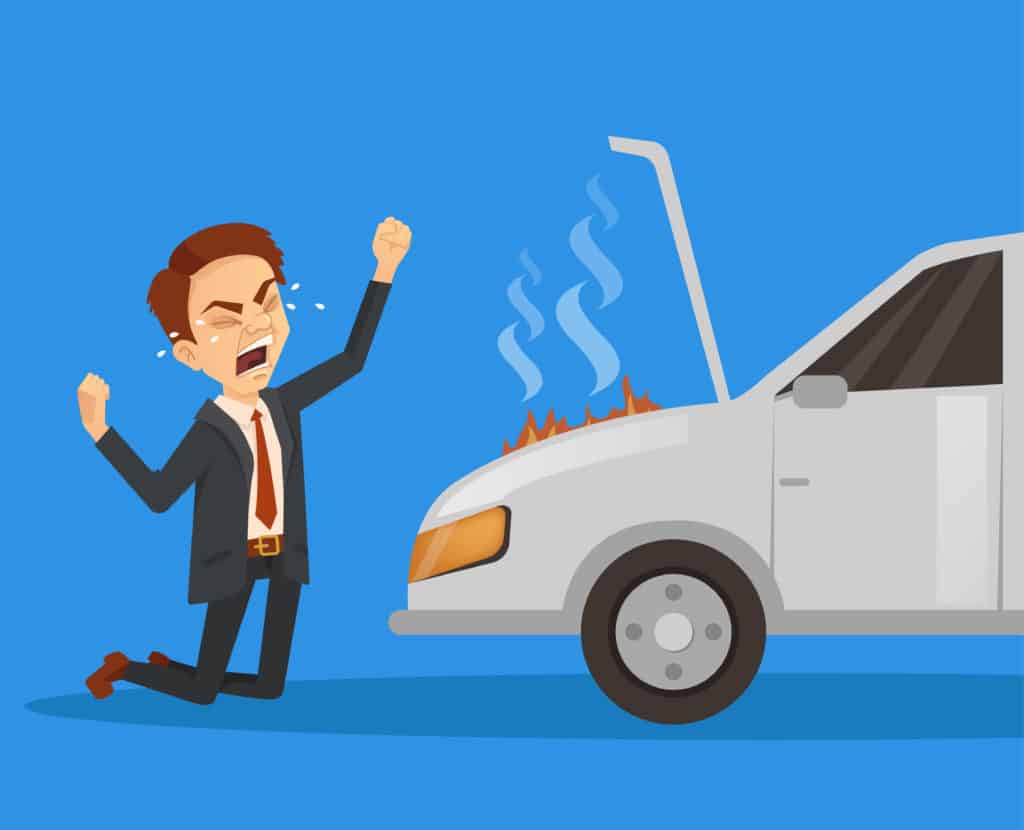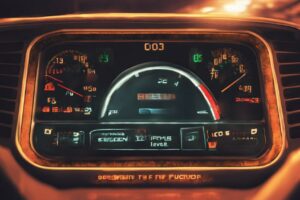If your car is overheating when you are driving then you could be slowly killing your engine.
Overheating is one of the worst things that can happen to your engine. It can cause irreversible damage to the engine, especially if left unfixed for a long period of time
Unfortunately, the first sign that an engine may be overheating is when the engine temperature needle shoots up into the red, or you get an overheating symbol flashing up on the dashboard.
As an Amazon Associate we earn from qualifying purchases.
In this article, we will look at the most common causes of engine overheating and what you should do if the engine warning light starts flashing on the dashboard when you are driving.
What are the 6 possible causes of engine overheating?
These problems will almost always be caused by failure of one or more parts of the coolant system. Here’s a quick a run down of the most common problems and how to fix them.
1. Low Coolant Level
This might seem like and obvious one, but over time, even without any leaks present, coolant can gradually evaporate from the system. The best time to check the coolant level is when the engine is cold. It should be between the min and max markings on the overflow/top-up bottle. It’s always a good idea to check your vehicles’ handbook, especially if you aren’t sure of what you should be looking at.
2. Coolant Leaks
If the coolant level is off, then you need to figure out why. Have a look around the engine for signs of a leak, especially under hoses and at the joints where they attach to the radiator and engine. If you see a split hose or leaky joint then you may have found the problem, otherwise top-up the coolant level and check it again in a few days.
If the coolant level has dropped again, but there are still no leaks, then the coolant may be leaking into the engine. This can be difficult to diagnose properly, but some warning signs include – rough engine idle, milky deposit under oil filler cap, higher than normal engine oil level, brown or dirty looking coolant in the coolant bottle.
3. Broken Water Pump
The water pump’s job is to pump the coolant around the engine. At full speed, it can move the coolant around the engine up to 20 times per minute! So over time, its impeller (the part the pumps the water) can start to break down and either become less efficient or stop working completely.
A broken water pump is often easy to diagnose, even without removing from the car. If the engine is overheating when not moving, there is coolant in the coolant bottle and the radiator fan is coming on when the engine heats up, then checking the water pump is next on your list.
Locate the pump, and check that there are no leaks and that the serpentine belt that runs the pump is not damaged or slipping. If the water pump is damaged, it will make a noise. There could be a broken or damaged impeller and this will make a loud clicking noise in time with the engine. If you suspect that the water pump is damaged, then you will need to remove it to have a closer look.
4. Blocked Hoses Or Blocked Radiator
If the coolant hasn’t been changed regularly, it can gather dirt and grit that can partially block the rubber hoses, leading to a decrease in coolant flow rate. In older cars especially, the radiator can get gunked up with dirt from the coolant. This decreases it’s efficiency and sometimes can lead to a total blockage.
To diagnose this, you may need to disconnect a few of the hoses so you can checkout their condition inside. If you find they are blocked or very dirty, then you are almost guaranteed that the radiator is in the same condition too. Sometimes a coolant system in this condition will still work but will be much less efficient, causing it to overheat sometimes.
5. Broken Coolant Thermostat
The thermostat controls the flow of coolant around the engine by monitoring the engine temperature. It does this by opening when the engine gets hot to allow coolant to flow to the radiator to cool and then back to the engine. If you have ruled out any problems with the rest of the system ,then it’s worth taking out the thermostat for a closer look.
6. Low Engine Oil Level
The oil in your car’s engine also helps to keep it cool. If you let the oil level go too low, this can also contribute to it overheating. It’s also very important to use the right oil in your car and to change it regularly.
Why Is My Car Overheating But There Are No Leaks?
The main cause of an overheating engine with no leaks is a faulty water pump, a broken thermostat or a blocked radiator.
If your car is overheating but there are no visible coolant leaks, or damaged hoses, then there is a problem with another part of the coolant system that is stopping the coolant from flowing freely around the system.
Here are a few possible reasons for your car overheating without any noticeable leaks:
- Cooling system problems: The cooling system is responsible for regulating the engine’s temperature. If there’s a problem within the cooling system, such as a malfunctioning thermostat, a blocked radiator, or a faulty water pump, it can lead to overheating. These issues may not necessarily result in visible leaks.
- Coolant loss or low coolant levels: Even without visible leaks, your car may be experiencing coolant loss. This can occur due to a faulty radiator cap, a blown head gasket, or internal engine leaks. Insufficient coolant levels can cause overheating as the coolant is unable to effectively cool the engine.
- Faulty radiator fan: The radiator fan helps in dissipating heat from the radiator. If the fan isn’t functioning properly, the radiator may not receive adequate airflow, leading to overheating. The fan could be faulty, the fan relay may have failed, or there could be an issue with the temperature sensor that controls the fan.
- Water pump failure: The water pump circulates coolant throughout the engine. If the water pump fails, coolant may not flow efficiently, resulting in overheating. While there may not be visible leaks, the pump’s internal components could be damaged.
- Clogged or restricted coolant passages: Over time, coolant passages in the engine can become clogged with debris, rust, or mineral deposits. These blockages impede the flow of coolant, causing overheating. The blockages may not be visible externally.
- Electrical or sensor issues: Your car’s temperature sensor or other related electrical components may be malfunctioning. This can lead to inaccurate temperature readings or improper control of the cooling system, causing overheating.
Even if there are no visible leaks, there can still be underlying issues within the cooling system that may need to be addressed to prevent permanent damage to the engine.
How does an engine cooling system work?
Every car, no matter what it’s age must have a working cooling system to keep it running at optimum temperature. Cooling systems are actually very simple and they all work using the same principles, no matter what engine they are cooling.
Early cars used a cooling system that consisted of directing cold air around the engine parts as the car moved. The cold air can be naturally flowing or can be directed using a motorized fan and shrouds to increase it’s effectiveness. In most cases, the cylinder head of an air cooled engine will be covered in fins to increase the surface area that can be cooled by the air.

One of the most famous air cooled engines was used in the Volkswagen Beetle. This simple design appeared in the late 1930’s and has lasted up until the present day.
As cars became more sophisticated with bigger more powerful engines, manufacturers switched to a pressurised water cooling system to keep the engine running at the right temperature.
This system works by pumping fluid known as coolant or antifreeze, through hoses and pipes around channels in the engine block. The cool fluid removes the heat from the engine, and then it is passed through a radiator that in turn cools the fluid. When the temperature gets too high there is usually a fan that helps dissipate the heat from the radiator.
Most passenger cars today have similar cooling systems comprised of the same basic parts. Usually when something goes wrong, it’s because of a problem with one of these parts. So here’s a quick overview of these parts and what they do.

1. Coolant/Antifreeze – This is the stuff that makes it all work. For normal climates, it’s a 50:50 mix of distilled water and coolant. The coolant is usually made from methanol or ethylene glycol. It increases the boiling point and lowers the freezing point of the water in the mix, making it a much more effective at dissipating heat.
2. Water pump – This is one of the most important parts of the coolant system. The role of the water pump is to pump the coolant around the engine, and it is driven by a serpentine belt that is run by the turning of the engine crankshaft.
3. Radiator – The radiator is located at the front of the engine where it is exposed to the cool air flow that comes in through the front grille of the car. The radiator helps to cool the coolant as it is pumped through it.
4. Coolant Expansion Bottle – This acts as an overflow and top up point for the coolant. It will have a minimum and maximum marking on it so you can easily tell if the coolant level is correct. A word or warning, don’t ever unscrew the cap from the lid while the engine is hot or you are likely to receive a nasty scald.
5. Coolant Thermostat – The role of the thermostat is to control the flow of the coolant around the engine and the heater core behind the dashboard. The heater core helps to heat the inside of the car when the engine is hot.
When the engine is cold, the thermostat is usually closed, blocking off the heater core part of the system. Once the engine heats up to a particular temperature, the thermostat will open, allowing the coolant to flow fully around the engine. Failure of the thermostat is a common fault as an engine gets older.
6. Rubber Hoses – Most cars use rubber hoses that connect the various parts of the system together, such as the coolant bottle to the engine block and the engine back to the radiator. These hoses tend to go hard over time with exposure to the heat from the engine, causing them to eventually crack and leak. This is one if the most common causes of an engine overheating.
What To Do if Your Car Overheats?

If you see the engine temperature needle in the red, or you get a warning light on the dashboard to warn you that your car’s engine is overheating, you will need to act quickly.
5 Symptoms of an overheating engine
- Steam coming from under the hood – If there’s a burst hose or a massive build up in pressure in the coolant system, then the coolant will try to escape. If it is at boiling point then it will try to escape as steam. This can also make the bonnet very hot, so be extra careful when trying to open it
- “Hot Smell” coming through the air vents in to the car – If the engine is overheating, then all of the parts in the engine will start to overheat too. This can create a hot fuel or rubber smell that you will often get in the passenger cab.
- Lack of engine power or rough idle – An overheated engine is not going to run efficiently. Even if your engine is only slightly overheated, the engine’s computer will try to adjust the fuel rate to compensate and this can affect performance. On top of that, the engine components can also expand, putting an extra strain on the engine.
- Fresh watery liquid on the engine or ground – A leaky water pump or rubber hose can often be quickly diagnosed by the trail of coolant that it is leaking. The liquid will often be red or blue in color.
- Empty/low water coolant bottle – This is one of the first places to check if you suspect the engine is overheating. If there is a coolant leak then the coolant level will be low. This can be a slow, gradual leak over a couple of weeks too, so it’s important to keep an eye on engine fluids.
The first thing you need to do is to try and cool the engine as much as possible, to minimize the potential damage. Once you have things under control, you can then start to investigate what’s going on.
what you should DO straight away if Your Car is overheating:
- If you are driving, then pull over immediately (or as soon as it is safe to do so).
- Don’t turn off the engine straight away, leave it running and open the bonnet to let some of the heat escape. Be careful, there may be some trapped hot air or steam from a burst hose.
- Don’t be tempted to touch any part of the engine yet, it will be very hot.
- Turn the heater in the car up to its maximum setting, then turn on the blower fan with all of the air vents open. This will help to suck some of the heat away from the engine bay. Make sure the air conditioning is turned off, you want to reduce the load on the engine.
- If the engine starts to cool down within a few minutes then shut off the engine, but leave the ignition on so the fans can continue to run. (In some cars you can do this by turning the key half way in the ignition, or press the start button without putting your foot on the brake/clutch)
Can Bad Radiator Symptoms Lead to Car Engine Overheating?
Recognizing bad radiator symptoms is crucial to preventing car engine overheating. Look out for signs such as coolant leaks, discolored coolant, or overheating. Follow the bad radiator symptoms recognition guide to address issues before they escalate into costly engine damage. Stay alert and proactive to keep your engine running smoothly.
What you should NOT DO when you Car is Overheating:
- Don’t continue driving. This can cause expensive or unfixable damage to your car.
- Don’t touch any engine parts. An overheated engine will reach temperatures in excess of 100°C/212°F , so obviously you don’t want to be touching that!
- Don’t open the coolant overflow/top-up bottle. There will be a build up of pressure and steam in the system, so unscrewing that lid can be dangerous.
How To Prevent Your Car From Overheating
The only way you can help to stop your car from overheating is to perform regular maintenance and checks.
1. Flush The Radiator and Cooling System
Coolant generally needs to be changed every 2 years, no matter what mileage you have done. The antifreeze properties of the coolant are gradually lost over time, and it can become gunked up with dirt and grit.
It’s a good idea to flush the system every couple of years to prevent blockages and to renew the coolant.
2. Change The Engine Oil Regularly
Engine oil not only lubricates the engine, but it also helps to dissipate heat from the engine block. Dirty, watery oil that has been in the engine for a long time won’t be as efficient at cooling or lubricating. It’s therefore important to stick to service schedules and change the oil at least once a year.
3. Top Up The Coolant Level
The coolant level can drop a small amount over time and it’s important that the level doesn’t drop below the minimum in the expansion bottle. You can buy small bottles of coolant that can be used for occasional top up. Don’t be tempted to add tap water to the expansion bottle, this will only dilute the coolant mix in the system.
4. Check For Coolant Leaks
This is an easy way to identify leaks before they get too bad. When the engine is cold, using a torch, go along each of the coolant hoses, squeezing them gently to see if there are any hairline cracks or drops of coolant. Sometimes cracks in hoses can start off small, before suddenly failing when you are speeding down the highway!
5. Check For Engine Fault Codes
If you really want to see how your engine is performing, then hook up an OBD2 reader and check for engine errors. Some readers will just list error codes, but more advanced models will allow you to check parameters such as engine temperature, oil pressure etc when the engine is running. If the engine isn’t running at the right temperature this may point to a problem with a coolant thermostat or some other coolant system component.
As an Amazon Associate we earn from qualifying purchases.































My car’s engine seems to overheat quickly on short drives, even before it fully warms up. Could this be related to a faulty thermostat, or should I be looking at another component first?
Could a malfunctioning temperature sensor cause my car to appear to overheat even if it actually isn’t?